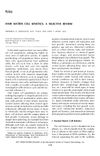45 citations
,
August 1992 in “PubMed” The study investigated the distribution of fibronectin, laminin, and type IV collagen during the rat vibrissa follicle growth cycle, focusing on their role in basement membrane restructuring. Laminin and type IV collagen were consistently present at the dermal-epidermal junction and within the dermal papilla, with changes in their distribution observed during different hair cycle phases. Fibronectin was abundant in the anagen phase but showed heterogeneous staining at telogen. These changes in extracellular matrix distribution were linked to modifications in basement membrane ultrastructure, suggesting that the lower vibrissa follicle can rapidly remodel its basement membrane, facilitating dermal-epidermal signaling. The findings indicated that dermal papilla cells might contribute to basement membrane formation and that fibronectin could regulate cellular activities within the follicle, highlighting dynamic cellular activity throughout the hair cycle.
 39 citations
,
April 1992 in “Development”
39 citations
,
April 1992 in “Development” Both cell and non-cell parts are important for rat whisker follicle regrowth.
85 citations
,
January 1991 in “Journal of Investigative Dermatology” 20 citations
,
July 1987 in “Development Genes and Evolution” 103 citations
,
December 1986 in “Journal of Investigative Dermatology” 4 citations
,
December 1985 in “Archives of Dermatological Research” The study investigated the growth of human epidermal and hair-follicle-sheath keratinocytes on different substrates: plastic, type-I collagen, and bovine eye lens capsules. It was found that eye lens capsules were the most effective substrate, as they facilitated a higher percentage of cultures with outgrowth and faster migration of epidermal keratinocytes compared to the other substrates. This was attributed to the presence of basement-membrane components, laminin and fibronectin, on the lens capsules, which mimic the in vivo environment. Additionally, the differentiation of keratinocytes on lens capsules was similar to those grown on irradiated, non-viable pig dermis, as indicated by the localization of bullous-pemphigoid antigen to the basal layer.
53 citations
,
April 1985 in “Developmental Biology” The study examined the expression of fibronectin and other basement membrane components during the hair growth cycle in rats. It was found that fibronectin levels varied significantly, being prominent in the dermal papilla matrix and basement membranes during the anagen (growth) phase, diminishing in the catagen (transitional) phase, and minimal in the telogen (resting) phase. The onset of anagen was marked by a significant increase in fibronectin, particularly around the dermal papilla, and was associated with cell division and follicle elongation. Immunoelectron microscopy confirmed these findings, showing fibronectin in vesicles near cell surfaces. Additionally, increased laminin and type IV collagen deposition in early anagen highlighted the role of basement membrane components in hair follicle morphogenesis.

